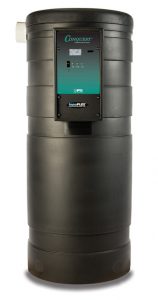— By Paul Bothner —
Selecting proper water heating solution can improve restaurant’s bottom line.
Restaurants use as much as five to seven times the amount of water per square foot than other commercial businesses, according to the National Restaurant Association (NRA). Water (often heated) is used to cook meals; clean dishes, floors and equipment; quench the thirst of customers; and to wash countless hands (staff and guests). NRA has also reported that quick-service restaurants consume 500 to 1,500 gallons of water each day while full-service eating establishments use as much as 5,000 gallons daily.

Paul Bothner, WATTS
Such a large amount of water usage means that selecting the proper water heaters can provide numerous benefits — including greater operating efficiency for cost savings, better overall operations and a favorable customer experience — to any eating establishment. Here are a few considerations to help select the proper water heater for your restaurant’s demands.
Water Heater Type
Restaurants have historically used tank-type water heaters to satisfy the demand. Their proven track record, as well as some distinct benefits, help tanked water heaters meet the specific requirements of a restaurant environment:
- Demand: A key benefit of a tank-type heater such as the unit shown in figure 1 is its ability to “over-drive” the gallons per minute (gpm) recovery of the unit to meet hot water requirements that exceed the capability of the burner alone to produce. For example, for two heaters with identical thermal efficiency of 95% and a BTU input of 199,000, the maximum recovery capacity at a 100° temperature rise would equal 3.8 gpm. In a tankless heater, that determines the maximum hot water delivery. A tank-type heater with some volume of water stored at the required delivered temperature permits about 5-6 gpm to be drawn from the tank for a reasonable period. If a restaurant experiences this scenario, two tankless heaters would have to be installed to meet this occasional demand.
- Scaling: Tank-type heaters are also less prone to scaling of the heat exchanger. Tankless heaters have heat exchangers with narrow tubes for the passage of water. These tubes are more susceptible to scaling and the resulting decrease in operating efficiency (heat transfer) is more profound. Regular maintenance is required to de-scale the exchanger in a tankless unit, whereas a tank-type heater is much less affected. It is important to note, however, that an annual combustion check should be performed on both tank-type and tankless.
- Sizing: A single-tank type heater is generally available in higher BTU input than a single tankless unit, meaning that a larger restaurant could be serviced from one tank-type heater of perhaps 500,000 BTU compared to two to four tankless units.
Reliability
In short, restaurants tax water heaters. They typically have a higher set point temperature of 140°F to 160°F. The demand cycle is also more strenuous than many other commercial environments, as the water heaters are almost continuously operating during the hours of food service, plus pre- and post-hours for preparation and cleanup.
The result is accelerated wear on the heaters that can dramatically shorten equipment life compared to other installation types. To ensure reliability and longer life, the design and materials of construction of the water heater must be considered.
The most common tank-type water heaters consist of steel tanks lined with porcelain enamel or glass. These heaters are popular due to a low manufacturing cost and a more economical price to the restaurant owner. It’s short-sighted, though. Porcelain enamel linings erode in hot water. As water temperature increases, so does the solubility rate of the lining. When the lining wears away, the underlying steel tank is exposed to hot water and tank corrosion is inevitable. While glass-lined tanks contain anode rods to govern the rate of corrosion of the steel tank, these devices are not infallible and begin to lose their ability to protect the steel as the exposed service area increases.
 Look for a different design. Water heaters that use a durable, corrosion-resistant duplex stainless steel alloy are more resistant to aqueous, crevice and pitting corrosion. These units also exhibit strong resistance to stress corrosion cracking that allows for higher reliability and longer life.
Look for a different design. Water heaters that use a durable, corrosion-resistant duplex stainless steel alloy are more resistant to aqueous, crevice and pitting corrosion. These units also exhibit strong resistance to stress corrosion cracking that allows for higher reliability and longer life.
Efficiency
Even though the high demand of a restaurant places an emphasis on reliability, the extreme level of hot water usage creates a faster return on investment (ROI) — if a high-efficiency condensing unit is used. For example, a 300,000 BTU condensing water heater in a typical high-volume restaurant can save an estimated $1,000 to $1,500 annually compared to a less efficient, non-condensing water heater. To reap greater financial benefits, ensure that the high efficiency equipment will have a long enough service life to achieve the promised payback.
Another way to improve efficiency is to use water heaters that employ burner modulation with a variable speed blower. This allows low flow conditions to be met with continuous, low BTU input and eliminate short cycling. The reduction in energy input also improves thermal efficiency up to 99%. During periods when nominal demand is only a few gpm, the at-temperature storage capacity of the unit can meet the hot water requirement for 20 to 40 minutes before a burner cycle is required.
Other variables that can aid in improving efficiency include:
- Focus on the application: Understanding that restaurants are a unique environment can help recognize how the water heaters should be used. For the highest operating efficiency and to ensure the immediate availability of hot water, public lavatories should be handled by point-of-use electric water heaters and separated from the main kitchen heater, whenever possible.
- Optimize settings: A simple method to save on water heating costs is to optimize the temperature setting. Water temperature is set by health code mandates. Typically, that means 120° F at hand sinks and 140° F to 180° F delivered to dish washers. Water temperatures that are set higher will waste energy, which can result is hundreds of dollars lost each year. Spend a few minutes at the hot water tank to adjust and optimize the settings to reap energy and financial savings.
Conclusion
Selecting and installing the most efficient water heater system is one of the most critical elements of restaurant design, given the amount of water used in eating establishments. By recognizing key considerations, the best water heating solution can be selected for greater profitability, improved operations and happy guests.
— Paul Bothner is director, hot water solutions, for WATTS. He has more than 30 years’ experience in the water heating market.
